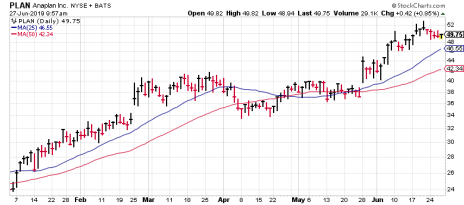Common Investing Logic Says to Keep Tight Stop Losses on Volatile Stocks. But That Can Cost You Money.
Due to Chris Preston’s prodding, I’ve finally started to put together my main presentation for our annual Cabot Wealth Summit, which is basically going to be something like “A Bunch of Things I Wish I Knew When I Started 20 Years Ago.” Note that I’m a terrible chooser of titles, so I’m sure the official name will be something that rolls off the tongue and sounds more attractive. But you get the point.
Anyway, I wanted to mention one of those lessons real quick because I’ve seen it come up a few times lately. The lesson: Loosen Your Stops. It sounds simple but is hard to do.
[text_ad]
How to Loosen Your Stops
When I first began at Cabot back in 1999, I knew all the common investing sayings, most of which are true. But one of them—use tight stops so you never lose big—ended up being a bit misleading. It turns out that those who keep tight stops on volatile stocks often lose more than those who use looser (but still reasonable) stops because they get shaken out of leading names on what turns out to be normal weakness.
That last part is key—your job is to understand what is “normal” action for a stock and then try to build your rules around that. And it turns out normal action for a big winner actually includes a ton of crummy action! Good-sized earnings gaps lower, underperformance for a few weeks, dramatic reversals, downgrades … you name it, and even the best performers suffer from them.
Thus, if your goal is to ride out an intermediate- to longer-term trend (granted, not everyone is shooting for that), you need to accept the fact that a growth stock can easily pull in 15%, 20%, sometimes 25% and loosen your stops based on that.
To be clear, that doesn’t mean you should use massively wide stops initially. I practice a “tight-to-loose” method where the initial loss limit would be maybe 10% to 12%, but once it gets going, I tend to loosen it out a bit. And if the run continues and I take partial profits, I can then give my remaining shares even more leeway so I can ride out normal corrections and benefit from a longer-term move.
I won’t get into all the details here (though feel free to join us at the Cabot Wealth Summit on August 14!), but suffice it to say that if you’re finding yourself repeatedly getting knocked out of stocks after a couple of bad weeks (only to see them rev up again), try to loosen your stops on your profitable holdings. Obviously, there will be times where you’ll wish you didn’t give your stock an extra few points, but all you need to do is avoid one shakeout to make a big difference in your portfolio.
New Market Rally Ahead?
Onto the market, I would characterize the environment as positive, but also tricky and rotational. From a top-down perspective, my trend-following measures are still bullish, and I’m encouraged to see that, despite the rally back toward new highs this month, many investors aren’t convinced, whether you’re reading sentiment from surveys (four straight weeks of more bears than bulls in the AAII survey) or from real money indicators ($40 billion has been yanked out of equity funds and ETFs over the past five weeks, an extreme figure).
Combined with some bullish background measures (like the blastoff indicators flashing green earlier this year) and I think it’s fair to say the odds favor higher prices ahead.
So it’s time to plow in, right? Not so fast. First off, history tells us that after the initial blastoff rally (which we saw from January through April) and the first correction (in May), any advance tends to be choppy—i.e., lots of volatility, three steps forward and two steps back, that sort of thing.
Second, even in this rebound, we’re seeing divergences, with the S&P 500 moving to new highs, but the Nasdaq and especially small and mid caps nowhere close to their prior highs.
And third, starting about a week ago, we’ve seen rotation out of leading growth stocks, some of which look toppy on a short- to intermediate-term basis.
So where does that leave us? I’m still leaning bullish, but as I usually do when the market perks up after a correction, I mostly want to get “pulled” into a heavily-invested stance via a bunch of strong stocks either breaking out or showing tight action. So far, I’ve definitely seen some of that, but for every fresh leader (including the stock below) out there, there’s been one that’s come under pressure.
Thus, I’m taking it on a stock-by-stock basis, taking profits (or partial profits) in extended leaders that are acting abnormally, but also keeping my eyes open for buying opportunities—ideally on pullbacks in stocks that have shown great upside power of late.
Foolproof PLAN?
One example that isn’t on my investors’ radar screen: Anaplan (PLAN), which is one of the “fresher” cloud software stocks out there. Here’s what I wrote about it in my Cabot Top Ten Trader advisory a couple of weeks back:
“Anaplan is one of the newer cloud-based software companies out there, having just come public last October. The elevator pitch?is that Anaplan is a pioneer in the connected planning software space, offering companies a platform that makes high-level planning a continuous, dynamic process rather than a static effort that’s completed only once a year. Anaplan’s Connected Platform allows for collaboration across organizational functions, including HR, finance, supply chain, marketing and operations, which gives it a large (estimated at $24 billion) and growing market to target. In large part because of that (and its leading products), analysts figure Anaplan has the potential to crank out revenue growth in the mid-20% range for several years. Given that revenue was up 40% in 2018 and 43% in fiscal 2019 (ended in January), that growth rate is easily attainable. The stock is doing well because the market agrees with Wall Street’s take—Anaplan just reported Q1 results last Tuesday and revenue growth of 47%, to $75.8 million, and EPS of -$0.16 (beat by $0.04) suggest the company is on tract to grow closer to 37% this year. Granted, the growth rate will slow as the revenue base expands, but with management expanding the partner ecosystem and smashing expectations on everything from subscription billings to large customer deals, big investors see this story going from good to great.”
Chart-wise, PLAN had a nice post-IPO run before building a solid launching pad during March, April and most of May. Then, not only did the stock break out on earnings, but it ramped as high as 52 in the weeks after on a huge pickup in trading volume.
It appears the stock is “growing up,” meaning institutions are building positions. It’s extended, but I’m not opposed to nibbling here or preferably on dips toward its rising 25-day line.
Now, if you want to know what momentum stocks I am currently recommending to my Cabot Top Ten Trader subscribers, simply click here.
[author_ad]



